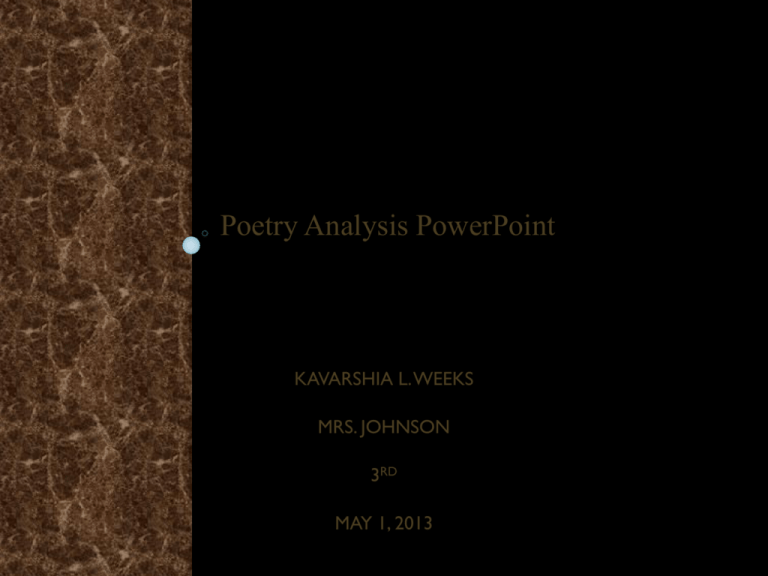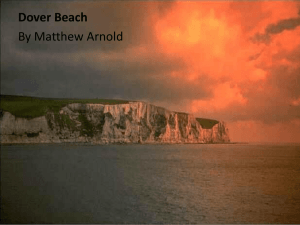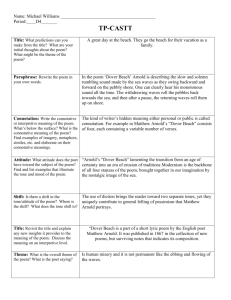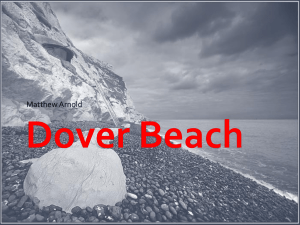File - K Week's E
advertisement

Poetry Analysis PowerPoint KAVARSHIA L. WEEKS MRS. JOHNSON 3RD MAY 1, 2013 DOVER BEACHMATTHEW ARNOLDS The speaker of the poem is Matthew Arnold- a British poet and critic who published Dover Beach in the collection of “New Poems” in 1867, though he worked on it before. He was born December 24, 1822 in Laleham, England and died at the age of 65 on April 15, 1888 in Liverpool, England. He was the son of Thomas Arnold and a brother to Tom Arnold and William Delafield Arnold. His brothers also were engaged in literary careers . Matthew Arnold focused his poems and literary work on genres such as social and religious criticism. He was considered one of the most significant writers of the late Victorian period in England; his reputation was established as a poet of elegiac verse. He was married to Frances Lucy and had 6 children. The name of his children were Thomas, Trevenen, Richard, Lucy, Eleanore, and Basil. He also attended Rugby School. BREIF SUMMARY OF THE PLOT Dover Beach is a poem signifying a beautiful beach and sea , yet, what is seen, is deeper than what the eye meets; human misery. Matthew is speaking to a loved one, who is known to be his wife, Frances Lucy. He explains to her the beauty of nature and how it gives one hope, faith. Throughout time at the beach he noticed that when the shore “draw back” and leave coldness and emptiness, that view caused a reflection of feeling inside of him. He noticed that people’s faith is within nature and when nature is destroyed so is ones’ faith. He used comparisons between the fight of nature and human misery. THESIS STATEMENT Throughout Matthew Arnolds’ poem he uses the literary devices of irony, appeal to the authority and visual sense, illusion , and mood to create a vision of a lost, hopeless, troubling, and , and sad soul . However, he objects with opposite mood. He uses the image of the beach, seashore, light, darkness, ignorant armies, and the shoreline to create a visual sense. In the last Stanza Matthew uses the verb “seems” to create an illusion that shows that it is only a dream of the lyrical “which can never become reality.” There is no specific pattern though there are rhyming words throughout the lines of the 4 Stanzas. . The poem doesn’t fully rhyme- there’s o rhyming scheme.. However, there are words that gives of a rhyming scheme such as the rhyming of words,; to-night, light; fair, night-air; stand, land; bay, spray; fling, bring; begin, in . He uses alliteration with words such as tonight, tide; full, fair; gleams, gone; coast, cliff . THEME The overall theme of the poem are challenges to the validity of long standing theological and moral precepts have shaken the faith of people in God and Religion. He’s basically saying that the faith that people have once put into nature and themselves have now suddenly ceased due to the changes of nature….the changes of themselves…and the changes of society. Nature provides a land of dreams…beauty…texture…quality..and diversity..people are only to provide the love, certainty, faith, joy, light, and so on for such. But losing faith for nature caused them to lose faith for themselves and be stuck in darkness….confusion. Matthew Arnold uses language in a very unusual way. It’s easy to understand what he’s saying excluding words such as darkling, cadence, and ebb. With carefully chose words, Matthew show cases the uncertainty of the future of humans. He uses a phrase such as “so various, so beautiful, so new” to infer a new industrialized world which destroyed nature causing it to only become a mere appearance. Losing faith due to that, he states the reality that mechanics can’t provide “neither joy, nor love, nor, nor light”. Only humans can do that. However, how could they, if nature is being bombarded by technology which is imprisoning their faith.. Ex: include: The Sea of Faith Was once, too, at the full, and round earth's shore Lay like the folds of a bright girdle furled. But now I only hear Its melancholy, long, withdrawing roar, Retreating, to the breath Of the night wind, down the vast edges drear And naked shingles of the world. To enhance the meaning of the poem Arnold uses uses parallel structure such as: The tide is full…the moon lies fair…and So various..So beautiful..So new (which is also repetition) and Nor love, nor light, nor certitude, nor peace, nor help for pain…(being repetition, also) Matthew uses assonance: The t[ide] is full, the moon l[ies] fair. Which the waves draw back, and fling….turbid ebb and flow of human misery…breathe of the nightwind. Lastly, he uses simile: The world, which seems to lie before us like a land of dreams. Specific Example He shifted the focus from the first stanza when Matthew starts from the “sweet is the night-air” to “eternal note of sadness.” Making a comparison from the beach about the world, society, he talks about calmness, certainty, and light of the beach..Sea….to the dullness, darkness and uncertainty of society. The most obvious poetic device he was an onomatopoeia. He used the term to create detail, have his reader to picture and feel connected to what he was saying…how he felt at the time of the uncertainty of life…nature….and peoples’ faith. Specific Example Grating roar of pebbles eternal note of sadness The poem states faith is being challenged by the people of earth in that time of society. Matthew Arnold relates nature (the beauty of it) to faith. Nature creates calmness, happiness, peace, joy but without it…when all cease/is destroyed..so does calmness, happiness, peace, and joy that society forces of it. Before time, when the Sea of Faith (nature) was once appreciated, cherished, and noticed: love, joy, light, certitude, peace, and help for pain was felt. All which are symbols of a “dove.” However, overtime, when society became blind to the beauty of nature and appealed to technology, all those thing ceased. Society became miserable, limited, and dull. Because of the blindness of nature, the people of society were confused because nature is in us and we are of nature. The attitude the poet have towards the poem is hope, faith, and love…but throughout at the same time, is lost of faith, confusion, darkness, and bitterness. Meaning that faith and appreciation was once put in themselves and nature, but overtime, all was lost and replaced with a dreary and bare feeling due to humans placing less importance on nature and emotions and more on technology. Examples: “The Sea of Faith was once too, at the full, and round earth’s shore lay like the folds of a bright girdle furled. But now I only hear it’s melancholy, long, withdrawing roar, of the night-wind, down the vast edges drear and naked shingles of the world.” …you hear the grating roar of pebbles which the waves draw back, and fling, …. Begin, and cease, and then again begin, With tremulous cadence slow, and bring The eternal note of sadness in. But now (I) only hear Its melancholy, long, withdrawing roar, Retreating, to the breath Of the night wind, love, let us be true To one another! for the world, which seems To lie before us like a land of dreams, So various, so beautiful, so new, Hath really neither joy, nor love, nor light, Nor certitude, nor peace, nor help for pain; and we are here as on a darkling plain Swept with confused alarms of struggle and flight, Where ignorant armies clash by night. CONCLUSION Throughout Matthew Arnolds’ poem he uses the literary devices of irony, appeal to the authority and visual sense, illusion , and mood to create a vision of a lost, hopeless, troubling, and , and sad soul . However, he objects with opposite mood. He uses the image of the beach, seashore, light, darkness, ignorant armies, and the shoreline to create a visual sense. In the last Stanza Matthew uses the verb “seems” to create an illusion that shows that it is only a dream of the lyrical “which can never become reality.” There is no specific pattern though there are rhyming words throughout the lines of the 4 Stanzas. . The poem doesn’t fully rhyme- there’s o rhyming scheme.. However, there are words that gives of a rhyming scheme such as the rhyming of words,; to-night, light; fair, night-air; stand, land; bay, spray; fling, bring; begin, in . He uses alliteration with words such as to-night, tide; full, fair; gleams, gone; coast, cliff . The mood, theme, figurative language, and poetic devices contribute d to the meaning and readability of the poem by allowing the reader to fully understand what the poet, Matthew Arnold, was referring to and why he referred to it. Usually poets would leave out many details but since Matthew Arnold detailed fluently with imagery, many metaphors, onomatopoeia, alliteration, illusions, and many more poetic devices, I was able to understand abruptly. I was able to connect and feel the emotions he carried within his poem. He seemed to have lost his faith in the beginning but he quickly pulled back together his faith. In life, he seemed to realized that where there is happiness, there is sadness. Where there is light, there is darkness, where there is love, there is hate and where there is war, there is peace. He realized that no matter how smoothly things go like the shore of Dover Beach, he knows certainty doesn’t exist. Something will ruin the moment erhaps. Work Cited Matthew Arnold (1822-1888) A Study Guide “Dover Beach” cummings@cummingsstudyguides.net Kaitlyn "Dover Beach" Poem Analysis Rated: E | Other | Philosophy | #1342661 http://www.writing.com/main/view_item/item_id/1342661-Dover-Beach-Poem-Analysis Katherine de Vere Poetry Summary and Analysis: Dover Beach by Matthew Arnold http://voices.yahoo.com/poetry-summary-analysis-dover-beach-matthew-4841054.html Summary and Analysis, Forms and Devices, Themes St. Rosemary Educational Institution. "Matthew Arnold’s Dover Beach: Summary & Analysis." http://schoolworkhelper.net/matthew-arnold%E2%80%99s-dover-beach-summary-analysis/ St. Rosemary Educational Institution, Last Update: 2013. Web. Retrieved on:Thursday 2nd May 2013







